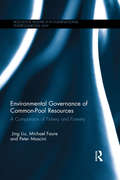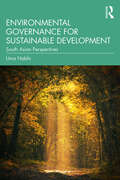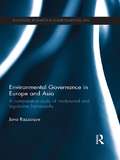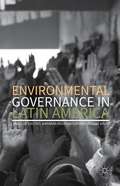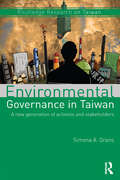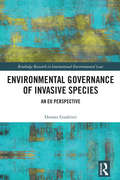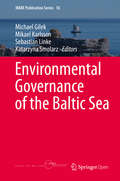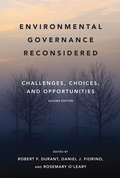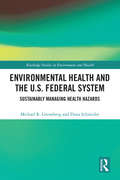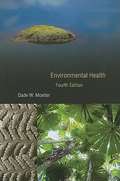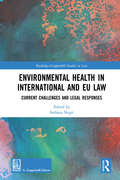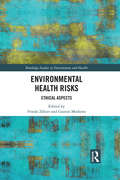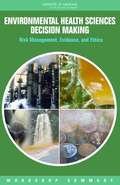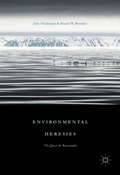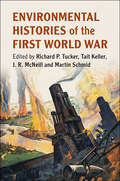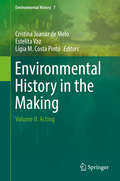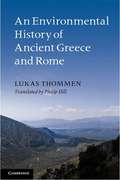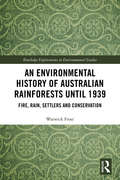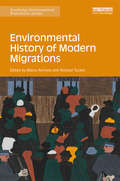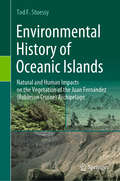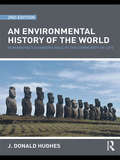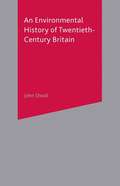- Table View
- List View
Environmental Governance and Common Pool Resources: A Comparison of Fishery and Forestry (Routledge Research in International Environmental Law)
by Michael Faure Jing Liu Peter MasciniThis book analyses the drivers of specific common pool resource problems, particularly in fisheries and forestry, examining the way in which private and public regulation have intervened to fight the common pool resource problem by contributing to the establishment and maintenance of property rights. It focuses on the various forms of regulation that have been put in place to protect fisheries and forestry over the past decades – both from a theoretical as well as from a policy perspective – comparing the concrete interaction of legal and policy instruments in eight separate jurisdictions.
Environmental Governance for Sustainable Development: South Asian Perspectives
by Uma NabhiThis book studies the role of the United Nations Environment Programme (UNEP) as an advocate for greater environmental responsibility and analyses the major achievements and outcomes of two landmark conferences – Stockholm (1972) and Rio (1992) – which set the agenda for the future role of the UNEP. It discusses the UNEP’s evolution, objectives and the problems of differing perspectives within, its ability to deal with environmental challenges, its skill in successfully carrying out the mandate and contributing to the pursuit of environmental security. The book also looks at five developing countries of South Asia, namely India, Bangladesh, Nepal, Pakistan and Sri Lanka, to study the role of the South Asia Co-operative Environment Programme (SACEP), which plays an active role in the management of environmental issues and constitutes an important landmark in regional cooperation in South Asia. The author evaluates the contributions of National Conservation Strategies not only in creating environmental awareness but also in strengthening environmental governance architecture by integrating Millennium Development Goals and Sustainable Development Goals into the development planning of these South Asian countries under study. Drawing on in-depth research and interviews, this book will be of interest to students, teachers, researchers, policymakers and strategic analysts working in the fields of environment studies, sustainable development, environmental science and policy, environmental law and governance, geography, politics and international affairs.
Environmental Governance in Europe and Asia: A Comparative Study of Institutional and Legislative Frameworks (Routledge Research in International Environmental Law)
by Jona RazzaqueThis book looks at environmental governance in both Asia and Europe and offers a comparative analysis of the two regions in order to provide a better understanding of the concept of ‘environmental governance’ and its status in Europe and Asia. The book assesses the legislative, institutional and participatory mechanisms which affect the overall development of environmental governance, and analyses current issues, concerns and strategies in respect of environmental governance at the local, national, and international levels. The rapid changes in economic, social and political life have had an enormous impact on Asia’s ecosystems and resources. Asian countries, in the name of economic development, are following the same environmentally destructive path their European counterparts followed in the past. The key to the environmental future of these two regions lies in the evolution of the character of governance - the ensemble of social ethics, public policies and institutions which structure how state actors and the civil society interact with the environment. This book will be valuable to scholars and students of environmental politics, EU and Asian studies, public policy, environmental law, and to decision makers and policy analysts.
Environmental Governance in Latin America
by Barbara Hogenboom Michiel Baud F�bio CastroThe multiple purposes of nature – livelihood for communities, revenues for states, commodities for companies, and biodiversity for conservationists – have turned environmental governance in Latin America into a highly contested arena. In such a resource-rich region, unequal power relations, conflicting priorities, and trade-offs among multiple goals have led to a myriad of contrasting initiatives that are reshaping social relations and rural territories. This edited collection addresses these tensions by unpacking environmental governance as a complex process of formulating and contesting values, procedures and practices shaping the access, control and use of natural resources. Contributors from various fields address the challenges, limitations, and possibilities for a more sustainable, equal, and fair development. In this book, environmental governance is seen as an overarching concept defining the dynamic and multi-layered repertoire of society-nature interactions, where images of nature and discourses on the use of natural resources are mediated by contextual processes at multiple scales.
Environmental Governance in Taiwan: A New Generation of Activists and Stakeholders (Routledge Research on Taiwan Series)
by Simona A. GranoThree decades of rapid industrialization until the lifting of martial law in 1987, with little or no concern for the environment, have made Taiwan’s environmental degradation a serious problem. In the past twenty years, Taiwan has seen a surge of environmental organizations, which to a certain degree have enjoyed a remarkable success in fighting polluting industries or affecting policies on behalf of the environment. This book aims to analyse environmental governance mechanisms and actors in Taiwan through a multi-disciplinary research approach. Based on extensive and original research, it includes four different case studies, which have all taken place since 2011. It focuses on four major elements of governance - specifically norms, actors, processes, and outcomes - to examine Taiwan’s national and local environmental governance in the post-2008 period. The book shows how the painful lessons Taiwan has learned throughout its transition should be of interest to other developing countries, illustrating how these positive transformations have managed to bring about a more ecologically friendly mode of economic development. Demonstrating that the battle to further ecological sustainability is also a battle to further democratisation, this book will be of interest to students and scholars of Taiwan Studies, Developmental Studies and Environmental Studies.
Environmental Governance of Invasive Species: An EU Perspective (Routledge Research In International Environmental Law Ser.)
by Donato GualtieriThe consequences of the introduction and spread of invasive alien species in non-native ecosystems is an area of growing interest for international policymakers and regulators. Globalisation has increased the rate and magnitude of biological invasions, resulting in huge environmental, economic and social costs. Until recently, the effectiveness of international efforts to provide a coordinated response to the threat of alien invasions have been limited. This book considers the existing Multilateral Environmental Agreements and looks at the potential role of regional environmental governance, particularly in consideration of the adoption of the European Parliament and Council regulation 1143/2014 on the management and control of invasive species, to provide an effective response to this global threat.
Environmental Governance of the Baltic Sea
by Michael Gilek Mikael Karlsson Sebastian Linke Katarzyna SmolarzThis edited volume presents a comprehensive and coherent interdisciplinary analysis of challenges and possibilities for sustainable governance of the Baltic Sea ecosystem by combining knowledge and approaches from natural and social sciences. Focusing on the Ecosystem Approach to Management (EAM) and associated multi-level, multi-sector and multi-actor challenges, the book provides up-to-date descriptions and analyses of environmental governance structures and processes at the macro-regional Baltic Sea level. Organised in two parts, Part 1 presents in-depth case studies of environmental governance practices and challenges linked to five key environmental problems - eutrophication, chemical pollution, overfishing, oil discharges and invasive species. Part 2 analyses and compares governance challenges and opportunities across the five case studies, focusing on governance structures and EAM implementation, knowledge integration and science support, as well as stakeholder communication and participation. Based on these cross-case comparisons, this book also draws a set of general conclusions on possible ways of improving the governance of the Baltic Sea by promoting what have been identified as vital functions of environmental governance: coordination, integration, interdisciplinarity, precaution, deliberation, communication and adaptability.
Environmental Governance Reconsidered, second edition: Challenges, Choices, and Opportunities (American and Comparative Environmental Policy)
by Robert F. Durant Daniel J. Fiorino Rosemary O'LearyKey topics in the ongoing evolution of environmental governance, with new and updated material.This survey of current issues and controversies in environmental policy and management is unique in its thematic mix, broad coverage of key debates, and in-depth analysis. The contributing authors, all distinguished scholars or practitioners, offer a comprehensive examination of key topics in the continuing evolution of environmental governance, with perspectives from public policy, public administration, political science, international relations, sustainability theory, environmental economics, risk analysis, and democratic theory.The second edition of this popular reader has been thoroughly revised, with updated coverage and new topics. The emphasis has shifted from sustainability to include sustainable cities, from domestic civic environmentalism to global civil society, and from global interdependence to the evolution of institutions of global environmental governance. A general focus on devolution of authority in the United States has been sharpened to address the specifics of contested federalism and fracking, and the treatment of flexibility now explores the specifics of regulatory innovation and change. New chapters join original topics such as environmental justice and collaboration and conflict resolution to address highly salient and timely topics: energy security; risk assessment, communication, and technology innovation; regulation-by-revelation; and retrospective regulatory analysis.The topics are organized and integrated by the book's “3R” framework: reconceptualizing governance to reflect ecological risks and interdependencies better, reconnecting with stakeholders, and reframing administrative rationality. Extensive cross-references pull the chapters together. A broad reference list enables readers to pursue topics further.Contributors Regina S. Axelrod, Robert F. Durant, Kirk Emerson, Daniel J. Fiorino, Anne J. Kantel, David M. Konisky, Michael E. Kraft, Jennifer Kuzma, Richard Morgenstern, Tina Nabatchi, Rosemary O'Leary, Barry Rabe, Walter A. Rosenbaum, Stacy D. VanDeveer, Paul Wapner
Environmental Health and the U.S. Federal System: Sustainably Managing Health Hazards (Routledge Studies in Environment and Health)
by Michael R Greenberg Dona SchneiderThis book explains how the U.S. federal system manages environmental health issues, with a unique focus on risk management and human health outcomes. Building on a generic approach for understanding human health risk, this book shows how federalism has evolved in response to environmental health problems, political and ideological variations in Washington D.C, as well as in-state and local governments. It examines laws, rules and regulations, showing how they stretch or fail to adapt to environmental health challenges. Emphasis is placed on human health and safety risk and how decisions have been influenced by environmental health information. The authors review different forms of federalism, and analyse how it has had to adapt to ever evolving environmental health hazards, such as global climate change, nanomaterials, nuclear waste, fresh air and water, as well as examining the impact of robotics and artificial intelligence on worker environmental health. They demonstrate the process for assessing hazard information and the process for federalism risk management, and subsequently arguing that human health and safety should receive greater attention. This book will be essential reading for students and scholars working on environmental health and environmental policy, particularly from a public health, and risk management viewpoint, in addition to practitioners and policymakers involved in environmental management and public policy.
Environmental Health (Fourth Edition)
by Dade W. MoellerBased on the recommendations of advisory bodies and federal agency regulations, as well as a thorough review of the scientific literature, Moeller's Fourth Edition is the only fully current text in this burgeoning field. It features new tables and figures, and revisions of those retained from previous editions. Environmental Health is also enriched with the knowledge and insights of professionals who are deeply involved in "real world" aspects of each subject covered. In eighteen chapters, students receive a complete but manageable introduction to the complex nature of the environment, how humans interact with it, and the mutual impact between people and the environments where they work or live. This new edition emphasizes the challenges students will face in the field: the local and global implications of environmental health initiatives, their short- and long-range effects, their importance to both developing and developed nations, and the roles individuals can play in helping to resolve these problems. Whether discussing toxicology, injury prevention, risk assessment, and ionizing and non-ionizing radiation, or more traditional subjects like the management and control of air, water, and food, Dade Moeller emphasizes the need for a systems approach to analyzing new projects prior to their construction and operation. Environmental Health is indispensable reading for practitioners, students, and anyone considering a career in public health.
Environmental Health in International and EU Law: Current Challenges and Legal Responses (Routledge-Giappichelli Studies in Law)
by Stefania NegriThis book presents a broad overview of the many intersections between health and the environment that lie at the basis of the most crucial environmental health issues, focusing on the responses provided by international and EU law. Consistent with the One Health approach and moving from the relevant international and EU legal frameworks, the book addresses some of the most important issues of environmental health including the traditional, such as pollution of air, water and soil and related food safety issues, as well as new and emerging challenges, like those linked to climate change, antimicrobial resistance and electromagnetic fields. Applying an intersectoral and interdisciplinary approach, it also investigates other branches of international and EU law including human rights law, investment law, trade law, energy law and disaster law. The work also discusses ethics and intergenerational equity. Ultimately, the book assesses the degree of effectiveness of the international and EU normative framework, and the extent to which the relevant legal instruments contribute to the protection of public health from major environmental hazards. The book will be a valuable resource for students, academics and policy makers working in the areas of Environmental Health law, Global Health law, International law and EU law.
Environmental Health Risks: Ethical Aspects (Routledge Studies in Environment and Health)
by Friedo Zölzer Gaston MeskensEnvironmental health involves the assessment and control of environmental factors that can potentially affect human health, such as radiation, toxic chemicals and other hazardous agents. It is less commonly understood that environmental health also requires addressing questions of an ethical nature. Bringing together work from experts across a range of sub-disciplines of environmental health, this collection of essays discusses the ethical implications of environmental health research and its application, presented at the 3rd International Symposium on Ethics of Environmental Health held in August 2016 in the Czech Republic. In doing so, it builds upon the insights and ideas put forward in the first volume of Ethics of Environmental Health, published by Routledge in early 2017. This volume will be of great interest to students and scholars of environmental health, applied ethics, environmental ethics, medical ethics and bioethics, as well as those concerned with public health, environmental studies, toxicology and radiation.
Environmental Health Sciences Decision Making: Risk Management, Evidence, and Ethics
by Institute of MedicineEnvironmental health decision making can be a complex undertaking, as there is the need to navigate and find balance among three core elements: science, policy, and the needs of the American public. Policy makers often grapple with how to make appropriate decisions when the research is uncertain. The challenge for the policy maker is to make the right decision with the best available data in a transparent process. The Environmental Health Sciences Decision Making workshop, the first in a series, was convened to inform the Roundtable on Environmental Health Sciences, Research, and Medicine on emerging issues in risk management, "weight of evidence," and ethics that influence environmental health decision making. The workshop, summarized in this volume, included an overview of the principles underlying decision making, the role of evidence and challenges for vulnerable populations, and ethical issues of conflict of interest, scientific integrity, and transparency. The workshop engaged science interest groups, industry, government, and the academic sector.
Environmental Heresies
by Juha Hiedanpää Daniel W. BromleyThis book systematically deconstructs the pervasive and counter-productive discourse surrounding environmental policy. The authors argue that environmental policy problems are always framed such that conflict is inevitable--a particular project or policy must be accepted versus a specific environmental asset that must be protected. Over the course of 12 chapters, the authors demonstrate that confident yet contradictory assertions by contending interests preclude necessary deliberation and reason giving. They argue that deliberation is an important social process of reflecting upon the reasons for doing something. Their innovative approach allows discourse and collaboration to continue, until--after honest and informed deliberation--the better way forward is arrived at. This approach to environmental policy illustrates just how very constructive and enabling the quest for the reasonable can be.
Environmental Histories of the First World War
by Richard P. Tucker Tait Keller J. R. McNeill Martin SchmidThis anthology surveys the ecological impacts of the First World War. Editors Richard P. Tucker, Tait Keller, J. R. McNeill, and Martin Schmidt bring together a list of experienced authors who explore the global interactions of states, armies, civilians, and the environment during the war. They show how the First World War ushered in enormous environmental changes, including the devastation of rural and urban environments, the consumption of strategic natural resources such as metals and petroleum, the impact of war on urban industry, and the disruption of agricultural landscapes leading to widespread famine. Taking a global perspective, Environmental Histories of the First World War presents the ecological consequences of the vast destructive power of the new weaponry and the close collaboration between militaries and civilian governments taking place during this time, showing how this war set trends for the rest of the century.
Environmental History in the Making
by Cristina Joanaz de Melo Estelita Vaz Lígia M. Costa PintoThis book is the product of the 2nd World Conference on Environmental History, held in Guimar#65533;es, Portugal, in 2014. It gathers works by authors from the five continents, addressing concerns raised by past events so as to provide information to help manage the present and the future. It reveals how our cultural background and examples of past territorial intervention can help to combat political and cultural limitations through the common language of environmental benefits without disguising harmful past human interventions. Considering that political ideologies such as socialism and capitalism, as well as religion, fail to offer global paradigms for common ground, an environmentally positive discourse instead of an ecological determinism might serve as an umbrella common language to overcome blocking factors, real or invented, and avoid repeating ecological loss. Therefore, agency, environmental speech and historical research are urgently needed in order to sustain environmental paradigms and overcome political, cultural an economic interests in the public arena. This book intertwines reflections on our bonds with landscapes, processes of natural and scientific transfer across the globe, the changing of ecosystems, the way in which scientific knowledge has historically both accelerated destruction and allowed a better distribution of vital resources or as it, in today's world, can offer alternatives that avoid harming those same vital natural resources: water, soil and air. In addition, it shows the relevance of cultural factors both in the taming of nature in favor of human comfort and in the role of the environment matters in the forging of cultural identities, which cannot be detached from technical intervention in the world. In short, the book firstly studies the past, approaching it as a data set of how the environment has shaped culture, secondly seeks to understand the present, and thirdly assesses future perspectives: what to keep, what to change, and what to dream anew, considering that conventional solutions have not sufficed to protect life on our planet.
An Environmental History of Ancient Greece and Rome
by Lukas Thommen Philip HillIn ancient Greece and Rome an ambiguous relationship developed between man and nature, and this decisively determined the manner in which they treated the environment. On the one hand, nature was conceived as a space characterized and inhabited by divine powers, which deserved appropriate respect. On the other, a rationalist view emerged, according to which humans were to subdue nature using their technologies and to dispose of its resources. This book systematically describes the ways in which the Greeks and Romans intervened in the environment and thus traces the history of the tension between the exploitation of resources and the protection of nature, from early Greece to the period of late antiquity. At the same time it analyses the comprehensive opening up of the Mediterranean and the northern frontier regions, both for settlement and for economic activity. The book's level and approach make it highly accessible to students and non-specialists.
An Environmental History of Australian Rainforests until 1939: Fire, Rain, Settlers and Conservation (Routledge Explorations in Environmental Studies)
by Warwick FrostThis book provides a comprehensive environmental history of how Australia’s rainforests developed, the influence of Aborigines and pioneers, farmers and loggers, and of efforts to protect rainforests, to help us better understand current issues and debates surrounding their conservation and use. While interest in rainforests and the movement for their conservation are often mistakenly portrayed as features of the last few decades, the debate over human usage of rainforests stretches well back into the nineteenth century. In the modern world, rainforests are generally considered the most attractive of the ecosystems, being seen as lush, vibrant, immense, mysterious, spiritual and romantic. Rainforests hold a special place; both providing a direct link to Gondwanaland and the dinosaurs and today being the home of endangered species and highly rich in biodiversity. They are also a critical part of Australia’s heritage. Indeed, large areas of Australian rainforests are now covered by World Heritage Listing. However, they also represent a dissonant heritage. What exactly constitutes rainforest, how it should be managed and used, and how much should be protected are all issues which remain hotly contested. Debates around rainforests are particularly dominated by the contradiction of competing views and uses – seeing rainforests either as untapped resources for agriculture and forestry versus valuing and preserving them as attractive and sublime natural wonders. Australia fits into this global story as a prime example but is also of interest for its aspects that are exceptional, including the intensity of clearing at certain periods and for its place in the early development of national parks. This book will be of great interest to students and scholars of Environmental History, Australian History and Comparative History.
An Environmental History of Latin America
by Shawn William MillerThis book narrates the mutually mortal historical contest between humans and nature in Latin America. Covering a period that begins with Amerindian civilizations and concludes in the region's present urban agglomerations, the work offers an original synthesis of the current scholarship on Latin America's environmental history and argues that tropical nature played a central role in shaping the region's historical development. Seeing Latin America's environmental past from the perspective of many centuries illustrates that human civilizations, ancient and modern, have been simultaneously more powerful and more vulnerable than previously thought.
Environmental History of Modern Migrations (Routledge Environmental Humanities)
by Marco Armiero Richard TuckerIn the age of climate change, the possibility that dramatic environmental transformations might cause the dislocation of millions of people has become not only a matter for scientific speculation or science-fiction narratives, but the object of strategic planning and military analysis. Environmental History of Modern Migrations offers a worldwide perspective on the history of migrations throughout the nineteenth and twentieth centuries and provides an opportunity to reflect on the global ecological transformations and developments which have occurred throughout the last few centuries. With a primary focus on the environment/migration nexus, this book advocates that global environmental changes are not distinct from global social transformations. Instead, it offers a progressive method of combining environmental and social history, which manages to both encompass and transcend current approaches to environmental justice issues. This edited collection will be of great interest to students and practitioners of environmental history and migration studies, as well as those with an interest in history and sociology.
Environmental History of Oceanic Islands: Natural and Human Impacts on the Vegetation of the Juan Fernández (Robinson Crusoe) Archipelago
by Tod F. StuessyThe Juan Fernández Archipelago is located in the Pacific Ocean west of Chile at 33° S latitude. Robinson Crusoe Island is 667 km from the continent and approximately four million years old; Alejandro Selkirk Island is an additional 181 km west and only one million years old. The natural impacts of subsidence and erosion have shaped the landscapes of these islands, resulting in progressive changes to their subtropical vegetation. The older island has undergone more substantial changes, due to both natural causes and human impacts. After the discovery of Robinson Crusoe Island in 1574, people began cutting down forests for lumber to construct boats and homes, for firewood, and to make room for pastures. Domesticated plants and animals were introduced, some of which have since become feral or invasive, causing damage to the local vegetation. The wealth of historical records on these activities provides a detailed chronicle of how human beings use their environment for survival in a new ecosystem. This book offers an excellent case study on the impacts that people can have on the resources of an oceanic island.
An Environmental History of Russia
by Paul Josephson Nicolai Dronin Aleh Cherp Ruben Mnatsakanian Dmitry Efremenko Vladislav LarinThe former Soviet empire spanned eleven time zones and contained half the world's forests; vast deposits of oil, gas and coal; various ores; major rivers such as the Volga, Don and Angara; and extensive biodiversity. These resources and animals, as well as the people who lived in the former Soviet Union – Slavs, Armenians, Georgians, Azeris, Kazakhs and Tajiks, indigenous Nenets and Chukchi – were threatened by environmental degradation and extensive pollution. This environmental history of the former Soviet Union explores the impact that state economic development programs had on the environment. The authors consider the impact of Bolshevik ideology on the establishment of an extensive system of nature preserves, the effect of Stalinist practices of industrialization and collectivization on nature, and the rise of public involvement under Khrushchev and Brezhnev, and changes to policies and practices with the rise of Gorbachev and the break-up of the USSR.
An Environmental History of the World: Humankind's Changing Role in the Community of Life
by J. Donal Hughes J. Donald HughesThis second edition of An Environmental History of the World continues to present a concise history, from ancient to modern times, of the interactions between human societies and the natural environment, including the other forms of life that inhabit our planet. Throughout their evolutionary history, humans have affected the natural environment, sometimes with a promise of sustainable balance, but also in a destructive manner. This book investigates the ways in which environmental changes, often the result of human actions, have caused historical trends in human societies. This process has happened in every historical period and in every part of the inhabited earth. The book is organized into ten chapters. The main chapters follow a chronological path through the history of mankind, in relationship to ecosystems around the world. The first explains what environmental history is, and argues for its importance in understanding the present state of the world's ecological problems. Chapters two through eight form the core of the historical analysis, each concentrating on a major period of human history (pre-civilized, early civilizations, classical, medieval, early modern, early and later twentieth century, and contemporary) that has been characterized by large-scale changes in the relationship between human societies and the biosphere, and each gives several case studies that illustrate significant patterns occurring at that time. The chapters covering contemporary times discuss the physical impacts of the huge growth in population and technology, and the human responses to these problems. Our moral obligations to nature and how we can achieve a sustainable balance between technology and the environment are also considered. This revised second edition takes account of new research and the course of history containing new sections on global warming, the response of New Orleans to the hurricanes Katrina and Rita, and the experience of the Dutch people in protecting their low-lying lands against the encroachments of rivers, lakes, and the North Sea. New material is also offered on the Pacific Islands, including the famous case of Easter Island. This is an original work that reaches further than other environmental histories. Rather than looking at humans and the environment as separate entities, this book places humans within the community of life. The relationship between environmental thought and actions, and their evolution, is discussed throughout. Little environmental or historical knowledge is assumed from the reader in this introduction to environmental history. We cannot reach a useful understanding of modern environmental problems without the aid of perspective provided by environmental history, with its illustrations of the ways in which past decisions helped or hindered the interaction between nature and culture. This book will be influential and timely to all interested in or researching the world in which we live.
An Environmental History of the World: Humankind's Changing Role in the Community of Life (Routledge Studies In Physical Geography And Environment Ser. #Vol. 2)
by J. Donald HughesThis second edition of An Environmental History of the World continues to present a concise history, from ancient to modern times, of the interactions between human societies and the natural environment, including the other forms of life that inhabit our planet. Throughout their evolutionary history, humans have affected the natural environment, sometimes with a promise of sustainable balance, but also in a destructive manner. This book investigates the ways in which environmental changes, often the result of human actions, have caused historical trends in human societies. This process has happened in every historical period and in every part of the inhabited earth. The book is organized into ten chapters. The main chapters follow a chronological path through the history of mankind, in relationship to ecosystems around the world. The first explains what environmental history is, and argues for its importance in understanding the present state of the world's ecological problems. Chapters two through eight form the core of the historical analysis, each concentrating on a major period of human history (pre-civilized, early civilizations, classical, medieval, early modern, early and later twentieth century, and contemporary) that has been characterized by large-scale changes in the relationship between human societies and the biosphere, and each gives several case studies that illustrate significant patterns occurring at that time. The chapters covering contemporary times discuss the physical impacts of the huge growth in population and technology, and the human responses to these problems. Our moral obligations to nature and how we can achieve a sustainable balance between technology and the environment are also considered. This revised second edition takes account of new research and the course of history containing new sections on global warming, the response of New Orleans to the hurricanes Katrina and Rita, and the experience of the Dutch people in protecting their low-lying lands against the encroachments of rivers, lakes, and the North Sea. New material is also offered on the Pacific Islands, including the famous case of Easter Island. This is an original work that reaches further than other environmental histories. Rather than looking at humans and the environment as separate entities, this book places humans within the community of life. The relationship between environmental thought and actions, and their evolution, is discussed throughout. Little environmental or historical knowledge is assumed from the reader in this introduction to environmental history. We cannot reach a useful understanding of modern environmental problems without the aid of perspective provided by environmental history, with its illustrations of the ways in which past decisions helped or hindered the interaction between nature and culture. This book will be influential and timely to all interested in or researching the world in which we live.
An Environmental History of Twentieth-Century Britain
by John SheailEnvironmental history - the history of the relationship between people and the natural world - is a dynamic and increasingly important field. In An Environmental History of Twentieth-Century Britain, John Sheail breaks new ground in illustrating how some of the most pressing concerns came to be recognised, and a response made. Much use is made of archival sources in tracing a number of key issues, including: * management of change by central and local government * the manner in which natural processes were incorporated in projects to protect personal and public health, and ultimately environmental health * new beginnings in forestry * the emergence of a third force alongside farming and forestry in the countryside * management of a transport revolution, and mitigation of environmental hazards Such instances of policy-making are reviewed within the wider context of a growing awareness, both on the part of government and business, of the role of environmental issues in the creation of wealth and social well-being for us all. An Environmental History of Twentieth-Century Britain is essential reading for all those concerned with these issues.
